| View previous topic :: View next topic |
| Author |
Message |
Peter Megaw
Site Admin

Joined: 13 Jan 2007
Posts: 975
Location: Tucson, Arizona



|
 Posted: Jan 27, 2010 23:00 Post subject: Re: Endomorph or Pseudomorph? Posted: Jan 27, 2010 23:00 Post subject: Re: Endomorph or Pseudomorph? |
|
|
John...never thought I'd live to hear you admit to being a slave of fashion! I love it!
_________________
Siempre Adelante! |
|
| Back to top |
|
 |
Peter Megaw
Site Admin

Joined: 13 Jan 2007
Posts: 975
Location: Tucson, Arizona



|
 Posted: Feb 20, 2010 19:47 Post subject: Re: Endomorph or Pseudomorph? Posted: Feb 20, 2010 19:47 Post subject: Re: Endomorph or Pseudomorph? |
|
|
Here's a puzzler I picked up at Tucson last week that plays to some recent discussions we've had regarding various mechanisms of pseudomorphing. This material has been around in many forms from Guanajuato for years...but generally as hollow shells of dolomite with the shape of precursor calcite that is gone. This one is different in that calcite is still there in the center with perfectly mirror smooth faces...and there is a void between the calcite and the dolomite shell. The interior-looking surface of the dolomite is crystallized, but not smooth, and tiny pyrites grew on both the smooth calcite faces and the interior dolomite face. Did the calcite grow inside the shell after an earlier calcite stage that was directly coated by dolomite was dissolved? or was the calcite covered with something that got covered by dolomite and was itself then dissolved. This would make the dolomite an epimorph after something other than calcite that itself took the shape of the calcite but is now gone. The pyrites add another dimension, they are clearly younger than both the calcite and dolomite shell, but did they grow in the void after the absent mystery phase got dissolved, or did they grow in it? It has been suggested that ephemeral phases of halite or gypsum/anhydrite...or even gels can grow between epithermal mineralization stages and later get removed leaving no trace.
Any thoughts of other possibilities, or other phases that might form and disappear into solutions that damage neither calcite nor dolomite?
| Description: |
| dolomite over calcite "epimorph" from Guanajuato, Mexico. Minature |
|
| Viewed: |
184350 Time(s) |
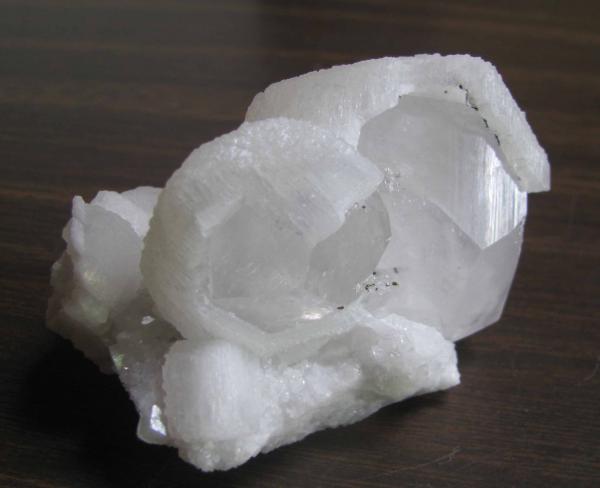
|
| Description: |
| close up showing void between dolomite overgrowth and smooth calcite foundation crystal |
|
| Viewed: |
184386 Time(s) |
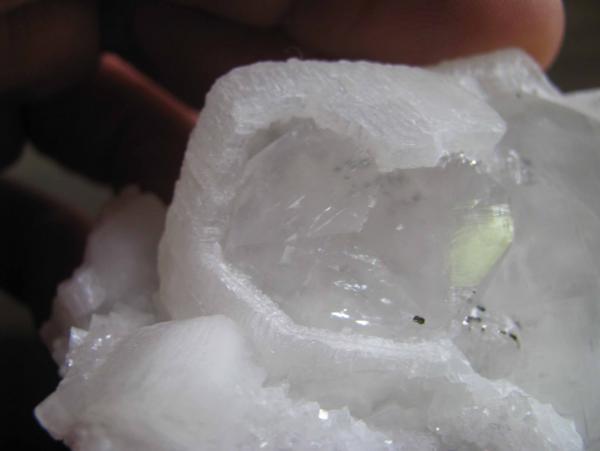
|
| Description: |
| close up of pyrite crystals on smooth calcite crystal face in void under dolomite |
|
| Viewed: |
184343 Time(s) |
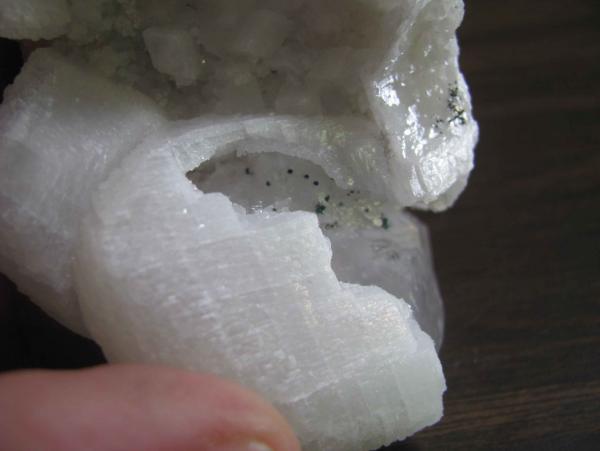
|
_________________
Siempre Adelante! |
|
| Back to top |
|
 |
dtkasper
Joined: 27 Dec 2010
Posts: 13
Location: Lancaster


|
 Posted: Dec 27, 2010 04:17 Post subject: Re: Endomorph or Pseudomorph? Posted: Dec 27, 2010 04:17 Post subject: Re: Endomorph or Pseudomorph? |
|
|
Neither.
The main band looks like a hash of zeolite, perhaps natrolite. They make the short rods with rounded tips. Then calcite formed on top of the hash. It encased most of the natrolite, but not all. Then silica intruded. The pink may, in fact, be from other related zeolites such as heulandite. Silica as chalcedony and agate has a strong propensity to precipitate in carbonate systems. In this case the silica precipitated in a limestone body. It is a vein deposit, so deposition was occurring inward from both sides at the same time. The center with the zeolites and calcite was the last open space before the final silica intrusion. The one-sided nature of the crystallization shows that this vein was probably far from vertical and the crystals are a geopetal indicating the original bottom of the formation. Vertical veins would be expected to have the mineralization pointed to the center from both sides, top and bottom of your specimen in this case.
|
|
| Back to top |
|
 |
dtkasper
Joined: 27 Dec 2010
Posts: 13
Location: Lancaster


|
 Posted: Dec 27, 2010 04:33 Post subject: Re: Endomorph or Pseudomorph? Posted: Dec 27, 2010 04:33 Post subject: Re: Endomorph or Pseudomorph? |
|
|
Neither.
The solution had two phases. The dolomite formed first and the calcite was entrapped second. The pyrite created some acidity leading to the dissolution of the calcite.
An equivalent with amygdules is found all the time. The amygdules are silica found with calcite rhombs in them and the only explanation people propose is meteoric waters intruding with calcite afterward. Of course, their are molds of calcite crystals on the outsides and insides of amygdules all the time. I say it came from one colloid and the crystallization favors silica precipitation first. The water is pushed up and out with the calcite. You get a blister on top commonly with calcite or druzy quartz.
Extrapolations across geologic systems has to be done carefully, but I see the common equivalence of silica and calcite all the time. Calcite forms at the very first and at the very end, two times and for different reasons (first insolubility at high temp, second degassing of CO2 at low temp) so the sequence of formation is always complex to unravel.
|
|
| Back to top |
|
 |
Jordi Fabre
Overall coordinator of the Forum

Joined: 07 Aug 2006
Posts: 5089
Location: Barcelona



|
|
| Back to top |
|
 |
vic rzonca

Joined: 18 Nov 2008
Posts: 820
Location: MA



|
 Posted: Jan 07, 2011 11:24 Post subject: Re: Endomorph or Pseudomorph? Posted: Jan 07, 2011 11:24 Post subject: Re: Endomorph or Pseudomorph? |
|
|
I must leave the extrapolations to others,(I am but a humble carpenter) Here are my two cents. Would it be called a quartz perimorph of calcite?
| Description: |
| Looking into the cavity left by calcite. |
|
| Viewed: |
182750 Time(s) |
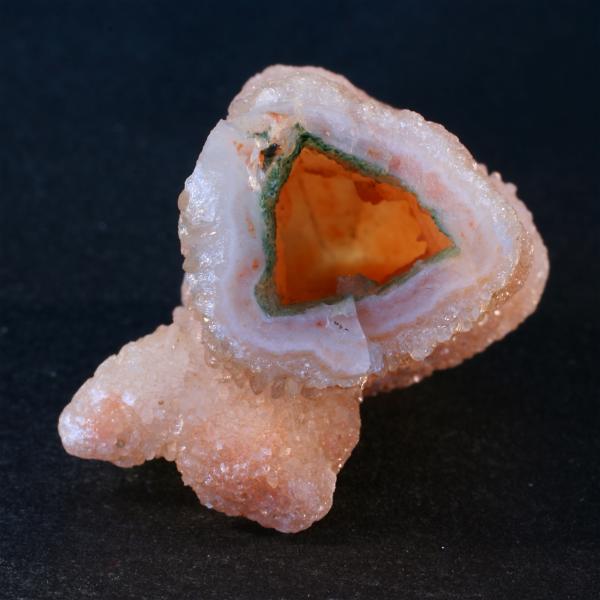
|
| Description: |
| 7x2 cm. quartz from Sakur, Maharashtra, India. |
|
| Viewed: |
182737 Time(s) |
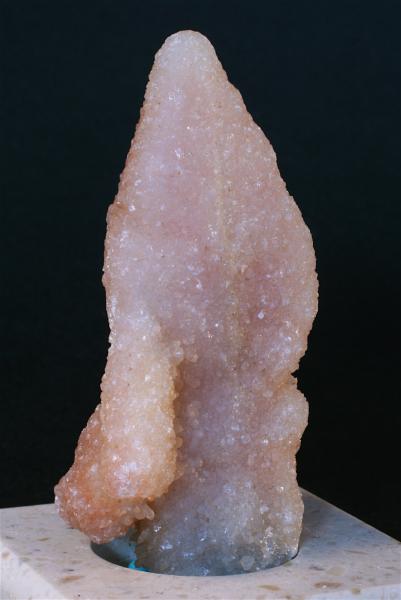
|
|
|
| Back to top |
|
 |
Peter Megaw
Site Admin

Joined: 13 Jan 2007
Posts: 975
Location: Tucson, Arizona



|
 Posted: Jan 07, 2011 12:18 Post subject: Re: Endomorph or Pseudomorph? Posted: Jan 07, 2011 12:18 Post subject: Re: Endomorph or Pseudomorph? |
|
|
Vic...I started out as a carpenter too...and I seem to remember there was a least one other humble carpenter who created a stir in his time?
If the shell is smooth on the inside this would suggest the quartz/chalcedony/silica gel coated the calcite and then built up layers farther outboard...this would make it an endomorph. The calcite probably dissolved as the temperature dropped given calcite's retrograde solubility.
If the shell is not smooth on the inside and there is evidence that the quartz actually replaced the calcite...perhaps along fractures or cleavage planes then it would be a (partial) replacement pseudomorph.
This would be a tougher call if banded quartz/chalcedony filled the core as well...it would be hard to tell if it did so after the calcite was dissolved or at the expense of the calcite. The crazylace agates of Chihuahua raise this question.
| Description: |
| Slab of crazy lace cut parallel to c-axis of earlier calcite. Note difference in banding patterns across what was obviously the outer surface of the calcite...suggesting there was filling of a void where calcite was removed on one side and layered build up on the other |
|
| Viewed: |
182763 Time(s) |
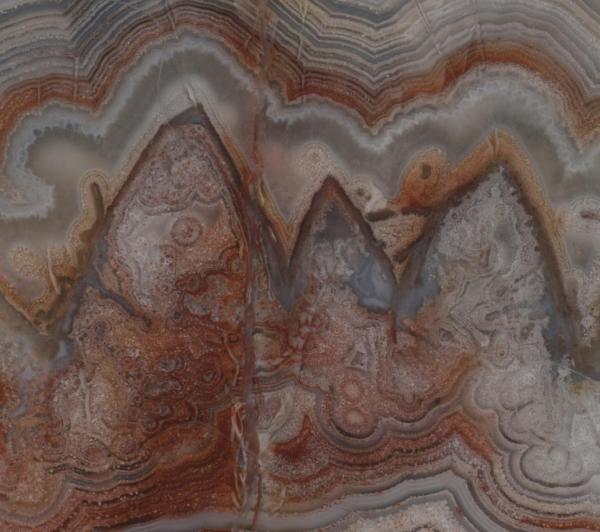
|
_________________
Siempre Adelante! |
|
| Back to top |
|
 |
vic rzonca

Joined: 18 Nov 2008
Posts: 820
Location: MA



|
 Posted: Jan 07, 2011 12:57 Post subject: Re: Endomorph or Pseudomorph? Posted: Jan 07, 2011 12:57 Post subject: Re: Endomorph or Pseudomorph? |
|
|
Carpentry's changed a lot since then, Pete. (I don't mean when you where in it)
On close examination of your agate, is there a live edge ( a woodworkers term for the original outer layer of a stem or trunk) or a visible starting plane where quartz nucleation began on the calcite face? Not sure if I'm being clear.
|
|
| Back to top |
|
 |
Peter Megaw
Site Admin

Joined: 13 Jan 2007
Posts: 975
Location: Tucson, Arizona



|
 Posted: Jan 07, 2011 13:09 Post subject: Re: Endomorph or Pseudomorph? Posted: Jan 07, 2011 13:09 Post subject: Re: Endomorph or Pseudomorph? |
|
|
I used a hammer and hand-saw...fairly ancient and unchanged technology.
Yes there is a live edge...you can see it right under the dark iron-stained layer
_________________
Siempre Adelante! |
|
| Back to top |
|
 |
vic rzonca

Joined: 18 Nov 2008
Posts: 820
Location: MA



|
 Posted: Jan 07, 2011 13:32 Post subject: Re: Endomorph or Pseudomorph? Posted: Jan 07, 2011 13:32 Post subject: Re: Endomorph or Pseudomorph? |
|
|
Nail guns , laser levels and sliding compound miter boxes, my infirmities insist.
Thanks Pete, very clear. Quite a study of process and sequence.
|
|
| Back to top |
|
 |
Peter Megaw
Site Admin

Joined: 13 Jan 2007
Posts: 975
Location: Tucson, Arizona



|
 Posted: Aug 20, 2013 13:39 Post subject: Re: Endomorph or Pseudomorph? Posted: Aug 20, 2013 13:39 Post subject: Re: Endomorph or Pseudomorph? |
|
|
Just got some new polished Crazy Lace slabs that show the differential/asymmetrical infilling patterns across the line representing the original calcite crystal.
Nice examples of the phenomenon...
Thanks to Jeff Galinger (Rock of Ages, Bailey Colorado) for the slabs and polishing
| Description: |
Crazy lace agate...chalcedony ps calcite
Sierra Santa Lucia, Chihuahua, Mexico
12 x 4 cm
Slabs clearly showing asymmetrical/differential "open-space" (or perhaps gel filing) on opposite sides of the original calcite crsytals |
|
| Viewed: |
168231 Time(s) |
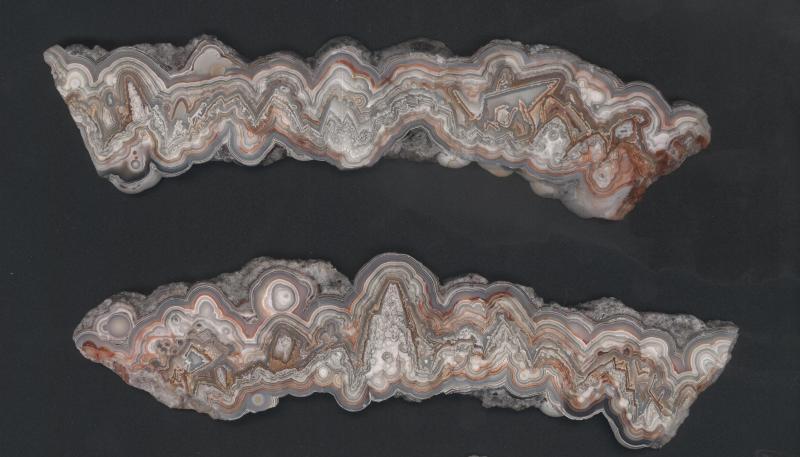
|
| Description: |
Crazy lace agate...chalcedony ps calcite
Sierra Santa Lucia, Chihuahua, Mexico
9 x 6 cm
really strong asymmetry in this pair. |
|
| Viewed: |
168363 Time(s) |
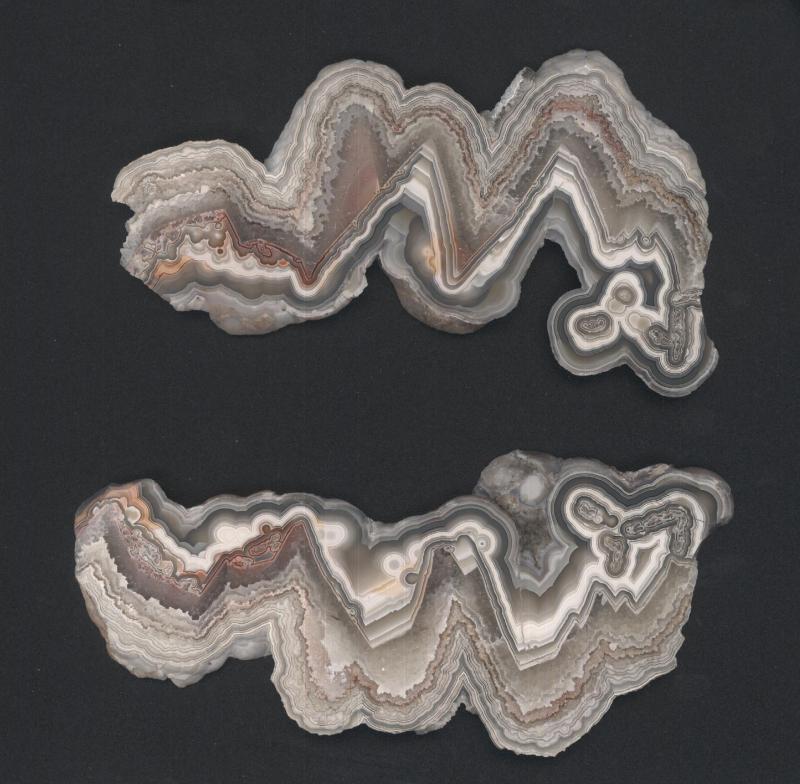
|
_________________
Siempre Adelante! |
|
| Back to top |
|
 |
marco campos-venuti

Joined: 09 Apr 2014
Posts: 234
Location: Sevilla



|
 Posted: Jul 22, 2014 12:46 Post subject: Re: Endomorph or Pseudomorph? Posted: Jul 22, 2014 12:46 Post subject: Re: Endomorph or Pseudomorph? |
|
|
I would add some theory about the genesis of Lace Agates as the Crazy Lace is.
Lace Agates:
-are vein agates formed in open systems
-show alternating banded chalcedony and others minerals such as quartz, calcite, aragonite or Baryte
-are often associated with ore deposits
Lace Agates are formed by two different mineralizing fluids, a concentrated one and a diluted one:
1-During the dry season, highly saline waters coming from a possible salt lake are responsible for the alkaline and colloidal solution that form the bands of chalcedony.
2-During the rainy season, a diluted solution, possibly heated by a hydrothermal system, often associated with a volcanic caldera, is responsible for the crystallization of quartz or other low temperature minerals.
There is more information in my book: Genesis and Classification of Agates and Jaspers: a New Theory by Marco Campos-Venuti:
https://www.agatesandjaspers.com/
(link normalized by FMF)
I don't know the geology of the Crazy Lace deposit, but I suspect there is a hydrothermal system associated with the ore deposit and it is highly possible it's related to a buried caldera system. On the other hand, a close salt lake is quite common in the Chihuahua Desert, nowadays or in the past.
So there is an alternation of silica waters that form banded agate and diluted waters that crystallize calcite or quartz. The more common in the Lace Agates is quartz alternated with chalcedony. When the colloidal solution comes again, the calcite is out of its stability field and is altered.
There are 2 or 3 phases of calcite in the Crazy Lace deposit and 4 or more of quartz.
Here some more picture of Crazy Lace, a really wonderful material for specimens, not only for cabochons.
| Description: |
Crazy Lace Agate
Chihuahua, Mexico
10 cm |
|
| Viewed: |
167942 Time(s) |
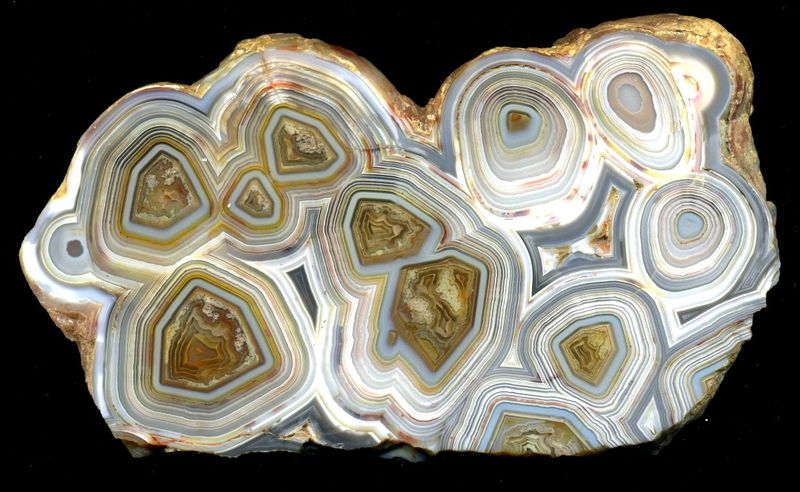
|
| Description: |
Crazy Lace Agate
Chihuahua, Mexico
25 cm |
|
| Viewed: |
167619 Time(s) |
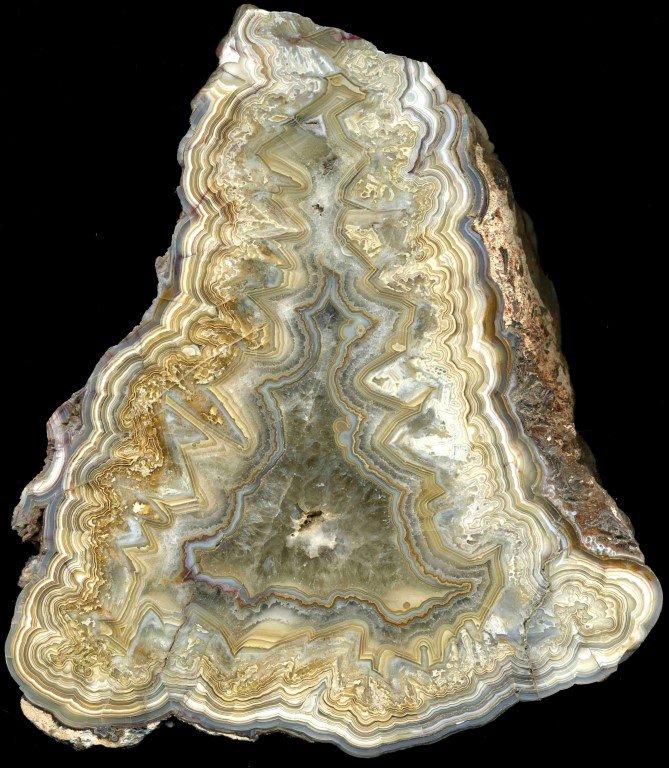
|
| Description: |
Crazy Lace Agate
Chihuahua, Mexico
15 cm |
|
| Viewed: |
167659 Time(s) |
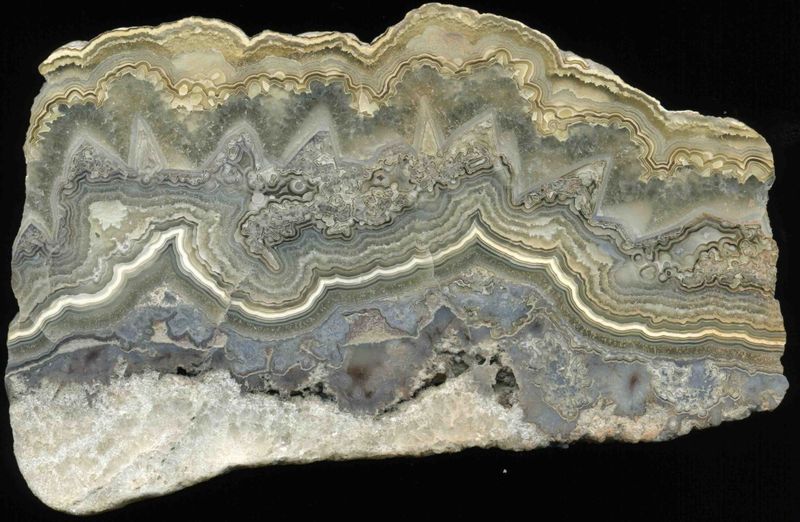
|
| Description: |
Crazy Lace Agate
Chihuahua, Mexico
30 cm |
|
| Viewed: |
167613 Time(s) |
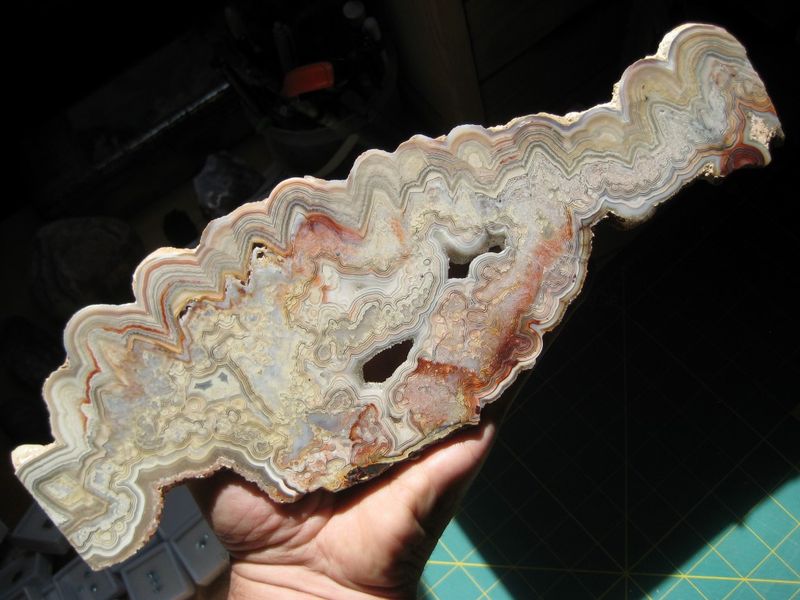
|
| Description: |
Crazy Lace Agate
Chihuahua, Mexico
9 cm |
|
| Viewed: |
167767 Time(s) |
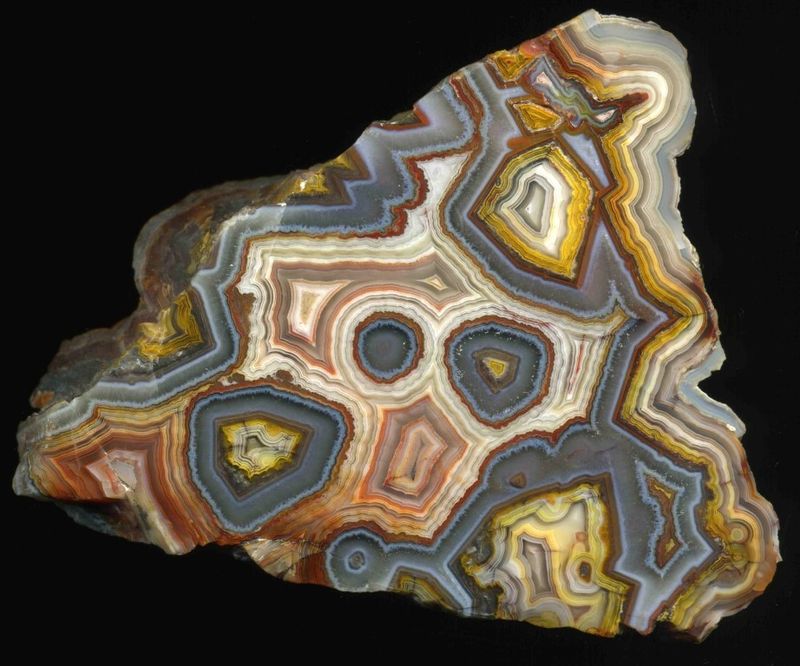
|
| Description: |
Crazy Lace Agate
Chihuahua, Mexico
35 cm |
|
| Viewed: |
167616 Time(s) |
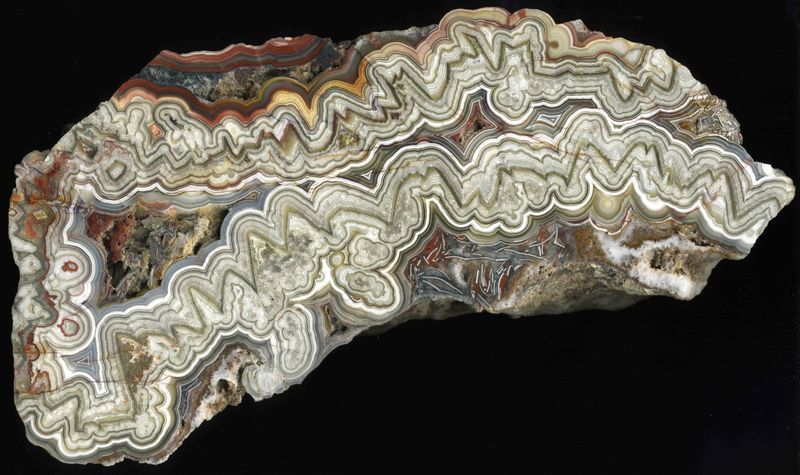
|
|
|
| Back to top |
|
 |
marco campos-venuti

Joined: 09 Apr 2014
Posts: 234
Location: Sevilla



|
 Posted: Jul 22, 2014 13:21 Post subject: Re: Endomorph or Pseudomorph? Posted: Jul 22, 2014 13:21 Post subject: Re: Endomorph or Pseudomorph? |
|
|
Another Crazy Lace with possibly Aragonite in the place of Calcite.
| Description: |
Crazy Lace Agate
Chihuahua, Mexico
9 cm |
|
| Viewed: |
167587 Time(s) |
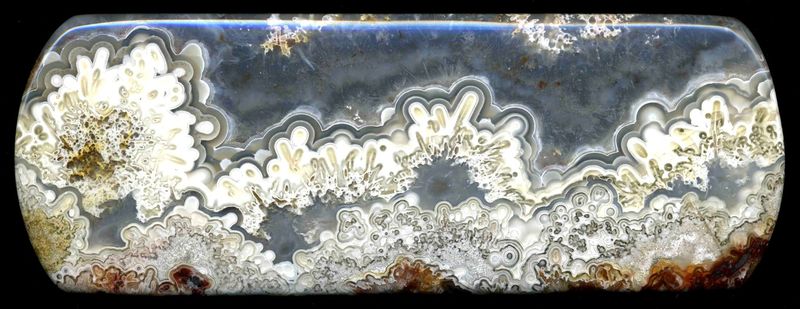
|
|
|
| Back to top |
|
 |
Dale Hallmark
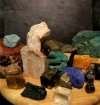
Joined: 16 Jun 2014
Posts: 189
Location: Texas Panhandle



|
 Posted: Jul 22, 2014 13:22 Post subject: Re: Endomorph or Pseudomorph? Posted: Jul 22, 2014 13:22 Post subject: Re: Endomorph or Pseudomorph? |
|
|
Thanks for posting these. Very nice material! I was never much of a fan of polished slabs but you have changed my opinion :-) I will have to shop around and educate myself.
Dale
|
|
| Back to top |
|
 |
Peter Megaw
Site Admin

Joined: 13 Jan 2007
Posts: 975
Location: Tucson, Arizona



|
 Posted: Jul 22, 2014 14:05 Post subject: Re: Endomorph or Pseudomorph? Posted: Jul 22, 2014 14:05 Post subject: Re: Endomorph or Pseudomorph? |
|
|
Dale...I felt much the same way when all I saw of this stuff was cabochons. Slabs, and working in the neighborhood, definitely changed my mind. There are a few dealers out there who specialize in agate slabs...for those of us old enough to remember browsing LP racks in the record store, the skills for flipping through slabs are the same!
Marco...there is no question about the link to the nearby hydrothermal ore deposit...some of the crazy lace pieces contain galena and others tetrahedrite (and weep copper oxides). Many contain specularite and nearly all have Baryte, which is a common gangue mineral in the nearby sulfide mineralization.
Geologically the "Laguna Lace" agates are infillings of collapsed paleo caves developed along a thrust fault. The caves were repeatedly filled with scalenhedral calcite and bladed Baryte (contemporaneous?) that was in turn repeatedly brecciated, both before and during deposition of various forms of silica. The attractive lace agates are only one manifestation of jasperoid alteration in the district. Virtually every major fault is marked with jasperoid, in some cases with Baryte with sporadic tetrahedrite. There ae places closer to the mineralization where multi-stage silica introduction ranges from cryptocrystalline chalcedony to coarse crystalline quartz (xtals to 5 cm).
There is good reason to believe that the agatized thrust fault is directly connected to the plumbing of the nearby ore deposit, which in turn can be traced from massive replacement sulfides to intrusive related skarn over at least 5 km laterally and 1 km vertically. The skarns and replacement sulfides show multiple stages of mineralization and brecciation that may correspond to the stages seen in the agates. Comparison with other CRD-skarn systems indicates there are fundamental pulses and stages of intrusive emplacement that drive the whole thing. Overall, the geology indicates the agates are indeed a peripheral alteration style to the integrated magmato-hydrothermal mineralization system. It is quite likely that the collapse breccias that host the agate are the products of episodic hydrothermal "karsting"
There are volcanic rocks (welded ash-flow tuffs and rhyolite flow domes) in the area (5 km away) but no recognizable caldera nearby. There are at least 2 mapped calderas 20-30 km to the south. Although there is an evaporate-rich dry lake 30 km to the north (Laguna Guzman, source of large sand gypsum groups), it is a relatively modern feature compared to the probable 30+ Ma ore deposit. We have seen no sign of evaporate rich layers in the alluvium...and we have LOTS of holes through it.
However, evaporates definitely exist down-section beneath the host limestones and are known to be extensive in the Chihuahua Trough (Basin) to the east. Sulfur isotope work indicates a significant basin brine component in the ore fluids and we have hypothesized that the big deposits are big because of a hybridization between magmatic and basin brine (MVT-like). This story was published in SEG Special Publication #4 in 1996.
| Description: |
Crazy Lace Agate
Sierra Santa Lucia, San Buenaventura, Chihuahua, Mexico
6 x 16 cm
Slab of crazy lace showing prominent Baryte-rich fragment within multi-stage agate fillings |
|
| Viewed: |
167590 Time(s) |
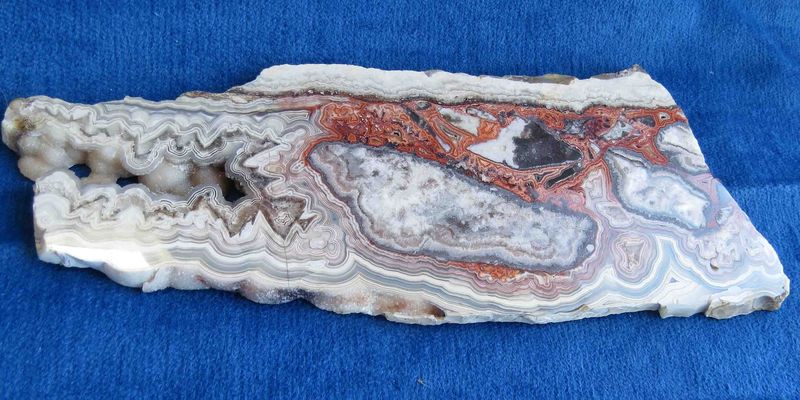
|
| Description: |
| Crazy lace agate pits, all developed along a thrust fault |
|
| Viewed: |
167575 Time(s) |
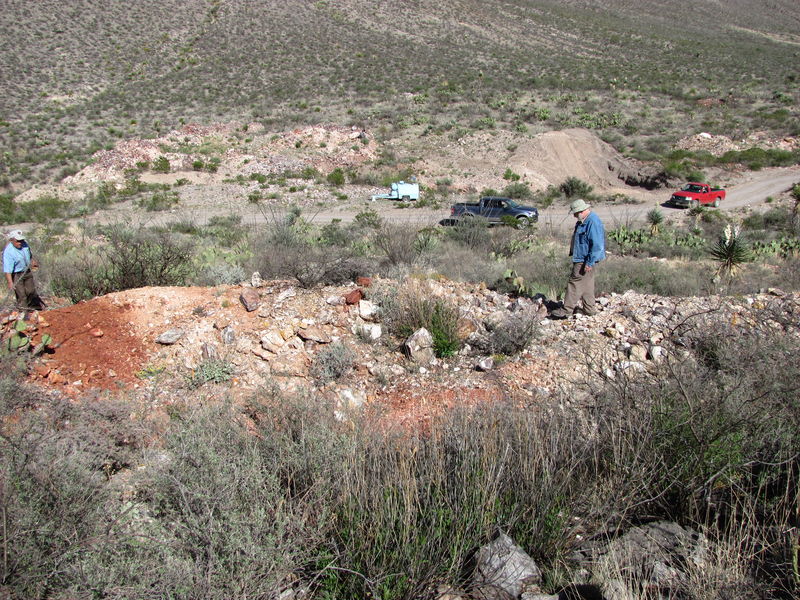
|
| Description: |
| crazy lace agate cementing paleokarst breccia |
|
| Viewed: |
167622 Time(s) |
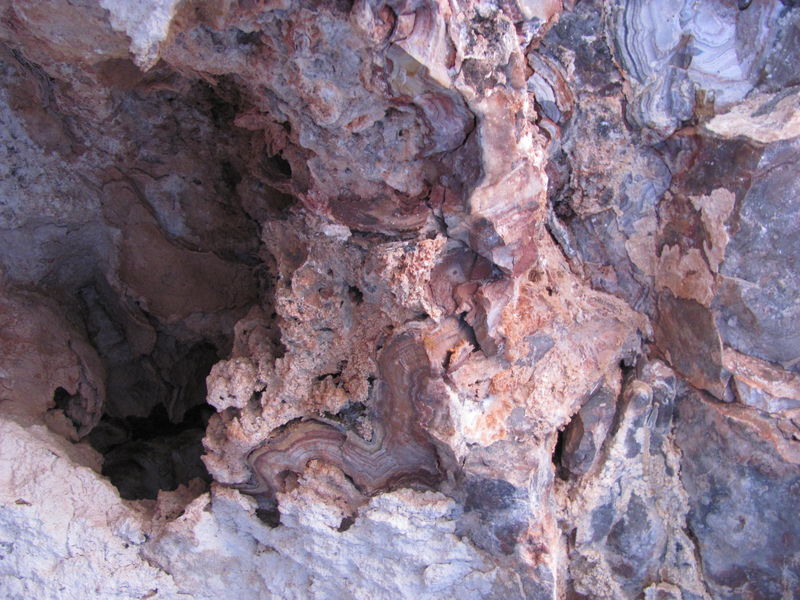
|
| Description: |
|
| Viewed: |
167618 Time(s) |
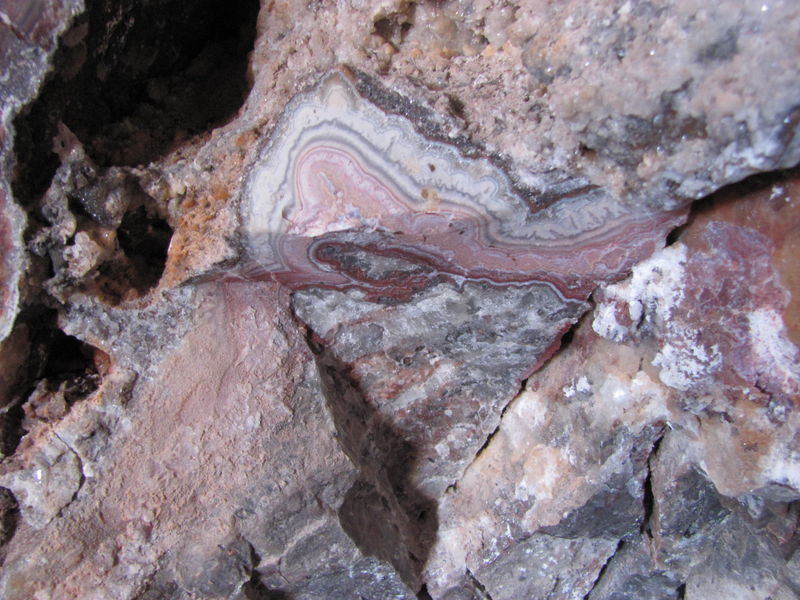
|
_________________
Siempre Adelante! |
|
| Back to top |
|
 |
|





